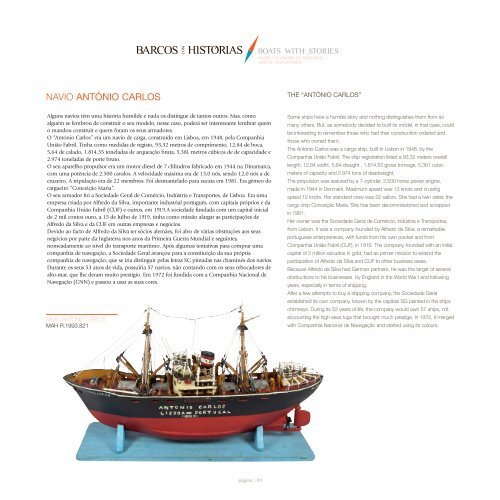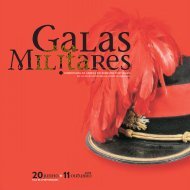Versão digital - Museu de Angra do Heroísmo
Versão digital - Museu de Angra do Heroísmo
Versão digital - Museu de Angra do Heroísmo
Create successful ePaper yourself
Turn your PDF publications into a flip-book with our unique Google optimized e-Paper software.
NAVIO ANTÓNIO CARLOS<br />
Alguns navios têm uma história humil<strong>de</strong> e nada os distingue <strong>de</strong> tantos outros. Mas, como<br />
alguém se lembrou <strong>de</strong> construir o seu mo<strong>de</strong>lo, nesse caso, po<strong>de</strong>rá ser interessante lembrar quem<br />
o man<strong>do</strong>u construir e quem foram os seus arma<strong>do</strong>res.<br />
O “António Carlos” era um navio <strong>de</strong> carga, construí<strong>do</strong> em Lisboa, em 1948, pela Companhia<br />
União Fabril. Tinha como medidas <strong>de</strong> registo, 93,32 metros <strong>de</strong> comprimento, 12,84 <strong>de</strong> boca,<br />
5,64 <strong>de</strong> cala<strong>do</strong>, 1.814,35 toneladas <strong>de</strong> arqueação bruta, 5,381 metros cúbicos <strong>de</strong> <strong>de</strong> capacida<strong>de</strong> e<br />
2.974 toneladas <strong>de</strong> porte bruto.<br />
O seu aparelho propulsor era um motor diesel <strong>de</strong> 7 clilindros fabrica<strong>do</strong> em 1944 na Dinamarca,<br />
com uma potência <strong>de</strong> 2.500 cavalos. A velocida<strong>de</strong> máxima era <strong>de</strong> 13,0 nós, sen<strong>do</strong> 12,0 nós a <strong>de</strong><br />
cruzeiro. A tripulação era <strong>de</strong> 22 membros. Foi <strong>de</strong>smantela<strong>do</strong> para sucata em 1981. Era gémeo <strong>do</strong><br />
cargueiro “Conceição Maria”.<br />
O seu arma<strong>do</strong>r foi a Socieda<strong>de</strong> Geral <strong>de</strong> Comércio, Indústria e Transportes, <strong>de</strong> Lisboa. Era uma<br />
empresa criada por Alfre<strong>do</strong> da Silva, importante industrial português, com capitais próprios e da<br />
Companhia União Fabril (CUF) e outros, em 1919.A socieda<strong>de</strong> fundada com um capital inicial<br />
<strong>de</strong> 2 mil contos ouro, a 15 <strong>de</strong> Julho <strong>de</strong> 1919, tinha como missão alargar as participações <strong>de</strong><br />
Alfre<strong>do</strong> da Silva e da CUF em outras empresas e negócios.<br />
Devi<strong>do</strong> ao facto <strong>de</strong> Alfre<strong>do</strong> da Silva ter sócios alemães, foi alvo <strong>de</strong> várias obstruções aos seus<br />
negócios por parte da Inglaterra nos anos da Primeira Guerra Mundial e seguintes,<br />
nomeadamente ao nível <strong>do</strong> transporte marítimo. Após algumas tentativas para comprar uma<br />
companhia <strong>de</strong> navegação, a Socieda<strong>de</strong> Geral avançou para a constituição da sua própria<br />
companhia <strong>de</strong> navegação, que se iria distinguir pelas letras SG pintadas nas chaminés <strong>do</strong>s navios.<br />
Durante os seus 53 anos <strong>de</strong> vida, possuiria 57 navios, não contan<strong>do</strong> com os seus reboca<strong>do</strong>res <strong>de</strong><br />
alto-mar, que lhe <strong>de</strong>ram muito prestígio. Em 1972 foi fundida com a Companhia Nacional <strong>de</strong><br />
Navegação (CNN) e passou a usar as suas cores.<br />
NAVIO ANTÓNIO CARLOS<br />
MAH R.1993.821<br />
página | 09<br />
THE “ANTÓNIO CARLOS”<br />
Some ships have a humble story and nothing distinguishes them from so<br />
many others. But, as somebody <strong>de</strong>ci<strong>de</strong>d to built its mo<strong>de</strong>l, in that case, could<br />
be interesting to remember those who had their construction or<strong>de</strong>red and<br />
those who owned them.<br />
The António Carlos was a cargo ship, built in Lisbon in 1948, by the<br />
Companhia União Fabril. The ship registration listed a 93,32 meters overall<br />
length, 12,84 widht, 5,64 draught , 1.814,53 gross tonnage, 5,381 cubic<br />
meters of capacity and 2.974 tons of <strong>de</strong>adweight.<br />
The propulsion was assured by a 7-cylin<strong>de</strong>r, 2.500 horse power engine,<br />
ma<strong>de</strong> in 1944 in Denmark. Maximum speed was 13 knots and cruising<br />
speed 12 knots. Her standard crew was 22 sailors. She had a twin sister, the<br />
cargo ship Conceição Maria. She has been <strong>de</strong>commissioned and scrapped<br />
in 1981.<br />
Her owner was the Socieda<strong>de</strong> Geral <strong>de</strong> Comércio, Indústria e Transportes,<br />
from Lisbon. It was a company foun<strong>de</strong>d by Alfre<strong>do</strong> da Silva, a remarkable<br />
portuguese enterpreneure, with funds from his own pocket and from<br />
Companhia União Fabril (CUF), in 1919. The company, foun<strong>de</strong>d with an initial<br />
capital of 2 million escu<strong>do</strong>s in gold, had as primer mission to extend the<br />
participation of Alfre<strong>do</strong> da Silva and CUF to other business areas.<br />
Because Alfre<strong>do</strong> da Silva had German partners, he was the target of several<br />
obstructions to his businesses by England in the World War I and following<br />
years, especially in terms of shipping.<br />
After a few attempts to buy a shipping company, the Socieda<strong>de</strong> Geral<br />
established its own company, known by the capitals SG painted in the ships<br />
chimneys. During its 53 years of life, the company would own 57 ships, not<br />
accounting the high seas tugs that brought much prestige. In 1972, it merged<br />
with Companhia Nacional <strong>de</strong> Navegação and started using its colours.



